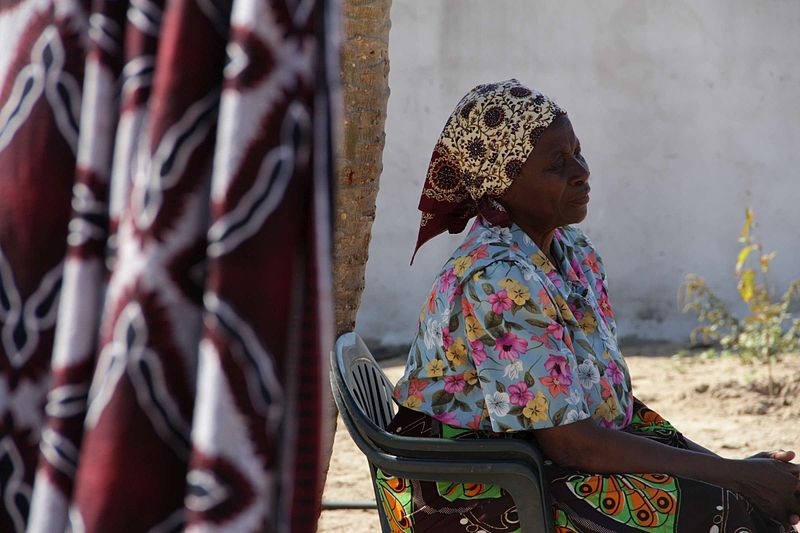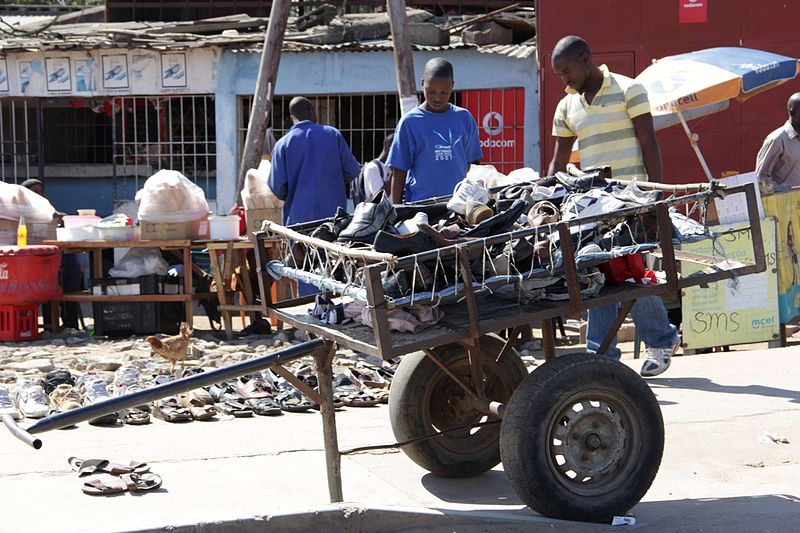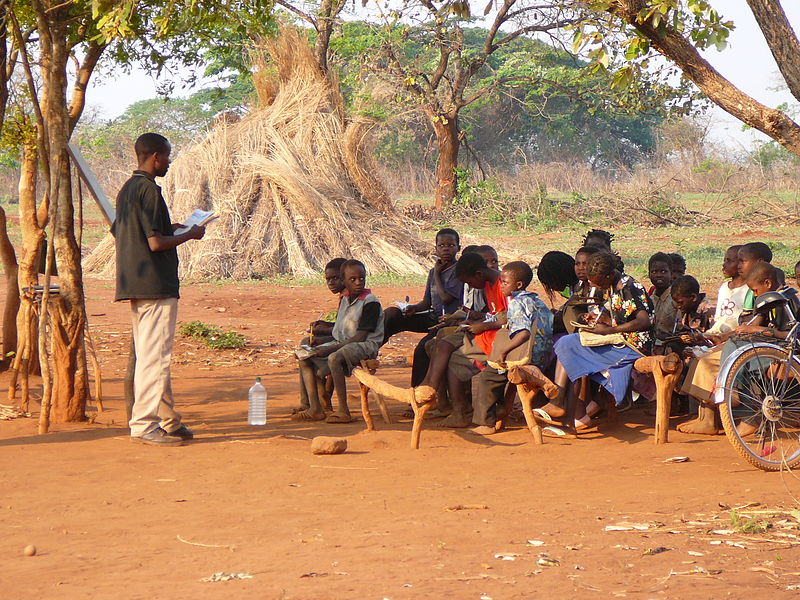Bom dia, welcome to Mozambique, the beautiful country in southern Africa!

Location
Mozambique is on the east coast of Africa. North of Mozambique lie Tanzania and Malawi, to the south South Africa and Swaziland. The neighboring countries to the west are Zimbabwe and Zambia. The island Madagascar is near the east coast. The long coastal line is covered in white sand beaches and mangrove woods. The mangroves are important because they protect the lowlands from flooding. With its coastal cities and seaports Mozambique played an important role in southern Africa as early as the Middle Ages.

The Zambezi merges into a large delta in the Indian Ocean. It separates the country into a northern part with tropical vegetation and a southern part with big cities.
For comparison: The country is about twice as big as Germany and is one of the most densely populated areas in the region.
Landscapes
Grasslands and savannah cover the midland of Mozambique. Acacias and baobabs grow here. During the dry season from May until October most trees loose their leaves, during the rainy season from November through April they become green again. Even the grass only becomes green during the rainy season and can become up to two meters tall then. A tropical climate reigns in Mozambique. You can expect temperatures between 25 and 30 °C here all year. Especially during the rainy seasons it becomes very hot and humid.
Maputo – the Capital of Mozambique

Maputo is a seaport on the southern coast of Mozambique. It is named after the river Maputo, which merges into the Indian Ocean here. The Portuguese built a fortress here and later Dutch seamen conquered the port. The city became one of the most important bases for ivory and whale salesmen. Today Maputo is one of the quickest growing metropolises in Africa. Around two million people live here today. Maputo consists of a geometrically shaped city center. The locals call it “cement city” because this is where the wealthy live in modern houses. The parts of Maputo surrounding the center are named “straw city”, this is where the poorer inhabitants live.
Peoples and Languages
Bemvindo a Moçambique! This is how you are greeted in Mozambique. The largest groups of peoples are the Makua and the Tsonga. Two thirds of the inhabitants live in villages and settlements. The rest is spread over the Maputo-area and the other cities.



More than 40 languages are spoken in Mozambique and almost everybody can speak at least two. Portuguese is the only official language. The most spoken languages are Makua and Changana.
Schools and Education
So, what about education in Mozambique? Take a close look at the flag of Mozambique at the top of this page. Next to the hoe, which stands for agriculture, and next to the rifle, which stands for protection, you will find a book! It symbolizes education and knowledge. But this is where many of the problems in Mozambique begin. Half of all grown-ups cannot read or write and two thirds of all women are illiterate. Since the end of the civil war in 1992 Mozambique is trying to better the schools and do more for teachers and their education. Therefore, about three quarters of all children visit school regularly. Most drop out after fifth grade, only a third finishes elementary school. School supplies such as desks and chairs but especially books are in very low supply. The classrooms are usually overfilled, 70 or more students squeeze themselves into a classroom. It gets worse in the rural areas as well. So why not just teach outdoors, is probably what the teacher on the picture in the left thought to himself.
Popular Games in Mozambique

Children in Africa are inventive. They know many games for which you barely need any toys and which you can play quite well with other children, such as the marble game Mancala, singing games, like the two girls on the picture are playing, and clapping ball. The children only need a small ball or a fruit. The players divide into two teams. The first player throws the ball to a player from the second group. While he throws, all children clap their hands. If the ball is caught all players stomp their feet. There are no winners or losers in this game, everybody is having fun and enjoying the rhythm.
Attractions

The Ilha de Mocambique with its mosques, churches, and its well-preserved colonial architecture is the only UNESCO world heritage of Mozambique. The buildings tell stories of trade, riches, slavery, and war but also of a fear of God and a sense of valor. Arabians built a trade post on the small island, which turned into a sultanate. In 1507 the Portuguese drove out the Arab rulers and created a trade branch. Afonso de Albuquerque ordered the construction of the San Sebastian fortress. The stones for the construction were transported to east Africa from Portugal! If you enjoy discovering nature, then go for a dive by the underwater coast of Mozambique. The coral reefs on endless white beaches are the home of exotic sea creatures. There aren’t many places in the world where the coral reefs are still as untouched as here.
Economy and Natural Resources
Mozambique is an agricultural country and belongs to one of the poorer countries in Africa. The rich mineral resources such as coal, salt, bauxite, iron, gold, oil, titan, aluminum, and gems have not been properly made accessible yet. Many international companies are coming into Mozambique to profit from the natural resources. The populace does not gain much from these large projects though. Two thirds of Mozambicans earn an average of 600 Dollars a year. Most did not finish school. They live from agriculture and fishing. Some of the coastal waters are still basically untouched and filled with fish.

The majority has to fight to survive here. With the sales of fish and sea creatures and planting coconut and pineapple trees women are able to make some money as well. Even children have to contribute. They sell self-made jewelry made of shellfish and pearls to tourists that visit the beaches. Since the civil war many thousand children live on the streets. They beg, wash cars, or guard parking lots and earn allowance like this. Some organize themselves in gang-like organizations and go on raids. These street children became famous through the street theater “TeatroAvenida”, which was founded by the author Henning Mankell.
Animal Kingdom

During civil war the wildlife was reduced dramatically. Especially elephants and rhinos were sought after for their precious ivory. By now, a lot has been done to protect the large wild animals. Together with South Africa and Zimbabwe the Great Limpopo Transfontier Park was created, which stretches over five countries. Many endangered inhabitants of the savanna can now feel at home here again. The ground pangolin in the picture on the left is nearly extinct. Its scaled body makes it look like it is still left over from the Stone Age. Amongst the reptiles the Mozambique spitting cobra needs to be mentioned because of its ability to spray its venom at the attacker's eyes.
Ecology

Environmental protection is noted in the constitution of 1990. During the long civil war nature and the environment suffered greatly. Many people living in rural areas moved into the cities. Many woods were intensely lumbered to create new living space. Even the mangrove woods were destroyed, even though they protect the coast from the incoming floods of the Indian Ocean. Environmentalists are facing another great problem in Mozambique. 40 percent of the land is supposed to be used to plant the Jatrophacurcas, also known as the purging nut. What is this plant for? Can you feed humans or animals with it? Unfortunately not! Organic diesel fuel is made with this plant. Environmentalists are warning that through the monoculture, many species may go extinct. They were able to ensure that only a part of the land is used for planting the Jatropha plant.
History

Mozambique`s first inhabitants were the Bushmen, the hunters and gatherers of the Stone Age. They lived in this area for thousands of years until the Bantu replaced them. The Bantu came from the Congo Basin and settled on the rivers and coasts of Mozambique. They built settlements and lived off of agriculture. Remnants of their culture, like ceramic pots and iron tools, were found in Chibuene, an old trading town between Mozambique and South Africa. This is how we know; the Bantu introduced the Iron Age in southern Africa. Starting in the 8th century after Christ Arabian merchants found their way to Mozambique. They created a trading network that reached all the way to India. This is how the islamization of the east coast began. On the right picture you can see an old carving of the Makonde, who live in Mozambique.
Mozambique Today

For many centuries, Mozambique was ruled by foreign powers. Today it is a free country with a democratic constitution. Mozambique is viewed as a safe country to travel to. It is not safe for tourists in the larger cities though. Especially in the capital Maputo break-ins and robberies occur regularly. Maputo is a young country, half of its population is younger than fifteen. Many children have lost their parents due to the aids epidemic. They are forced to live on the streets. They live as nomads, moving from one point to the next to get a job. They try to snap their way out of poverty. There is not much governmental help for the many street kids.







